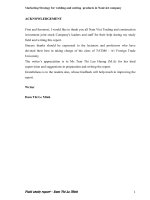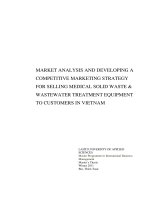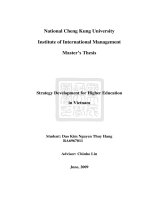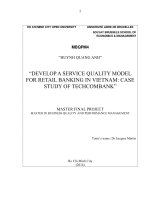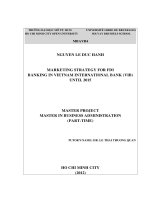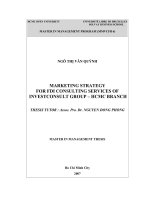Marketing strategy for FDI banking in Vietnam International Bank (VIB) until 2015
Bạn đang xem bản rút gọn của tài liệu. Xem và tải ngay bản đầy đủ của tài liệu tại đây (618.46 KB, 104 trang )
TRƯỜNG ĐẠI HỌC MỞ TP. HCM
HO CHI MINH CITY OPEN UNIVERSITY
UNIVERSITEÙ LIBRE DE BRUXELLES
SOLVAY BRUSSELS SCHOOL
MBAVB4
NGUYEN LE DUC HANH
MARKETING STRATEGY FOR FDI
BANKING IN VIETNAM INTERNATIONAL BANK (VIB)
UNTIL 2015
MASTER PROJECT
MASTER IN BUSINESS ADMINISTRATION
(PART-TIME)
TUTOR’S NAME: DR. LE THAI THUONG QUAN
HO CHI MINH CITY
(2012)
ii
COMMITMENT
I would like to commit that I have myself prepared and conducted my project titled
“ Marketing strategy for FDI Banking in Vietnam International Bank (VIB) until
2015” by the knowledge obtained from the MBAVB4 program and discussions with
my tutor, professors and classmates. All information, data and survey results are
retrieved and obtained from reliable sources and have been properly referred.
Ho Chi Minh City, February 2012
NGUYEN LE DUC HANH
iii
ACKNOWLEDGEMENTS
This thesis is my effort throughout two years working, studying hard at Solvay
Brussels School in Ho Chi Minh City. By that time, I have been accompanied and
supported by many people. It is a pleasure to convey my gratitude to them all in
my humble acknowledgement.
First of all, I would like to express my sincere gratitude to my tutor, Prof. Le Thai
Thuong Quan for his patience, motivation, enthusiasm, and immense knowledge.
His detailed and constructive comments have been of great value for me. No
words can express my heartfelt thanks to him.
It is a pleasure to show my thankfulness to VIB FDI Banking Division, to all who
assisted me in collecting data, supported me with useful information, especially the
managers with their supports during the writing project period.
I would also like to thank to all professors, lecturers, tutors and my classmates
who have shared with me not only knowledge, experiences but also special
moments during my learning time at Solvay Brussels School in Ho Chi Minh City.
Last but not least, I would like to express my special gratitude to my parents, my
husband and my sister for their love, support and encouragement throughout my
entire life. To them I dedicate this thesis.
Ho Chi Minh City, February 2012
Nguyen Le Duc Hanh
v
EXECUTIVE SUMMARY
Vietnam International bank (VIB) was established in 1996 under Decision
No.22/QD/NH5 issued by the Governor of the State Bank of Vietnam (SBV). Over
more than 15 year operating, VIB has been consistently in the top 5 joint stock
commercial banks in Vietnam. The year 2010 marked a significant development of
VIB by a strategic partnership with the Commonwealth Bank of Australia – a
leading retailer of Australia.
In order to maintain exclusive position, since early 2011, VIB has set up a newly
dedicated Foreign Direct Investment Division within VIB to serve foreign invested
companies in Vietnam. Given the fact that there are huge opportunities for VIB as
foreign direct investment is increasing year by year in Vietnam, VIB has to realize
its internal and external environment, their strengths and weakness so as to
compete in a very huge but severe market with a lot of big & experienced
competitors.
This thesis is carried out to assess the current marketing strategy of VIB FDI
banking and provide some recommendations for FDI banking so as to obtained
objectives assigned by the Board of Directors. By determining the marketing
segmentation using the quantitative and qualitative combination methodology, the
project explores that VIB is still a new brand name to FDI enterprises in Vietnam
and most FDI enterprises are not impressed by VIB quality of services. Thus, it is
necessary to suggest a suitable marketing strategy so VIB can compete effectively
in this severe market.
vi
TABLE OF CONTENTS
COMMITMENT ........................................................................................................ i
ACKNOWLEDGEMENTS ...................................................................................... iii
TUTOR’S COMMENTS .......................................................................................... iv
EXECUTIVE SUMMARY ........................................................................................ v
TABLE OF CONTENTS .......................................................................................... v
LIST OF ABBREVIATIONS .................................................................................... ix
LIST OF FIGURES................................................................................................. xi
LIST OF TABLES .................................................................................................. xii
Chapter 1: Introduction ............................................................................................ 1
1.1 Rationale of the study .................................................................................. 1
1.2 Problem statement....................................................................................... 2
1.3 Research objectives and questions ............................................................. 3
1.3.1 Research objectives: ............................................................................. 3
1.3.2 Research questions: ............................................................................. 3
1.4 Scope and limitations of the study: .............................................................. 3
1.5 Research method: ....................................................................................... 4
1.5.1 Desk Research (Secondary data) ......................................................... 4
1.5.2 Quantitative research (primary data) ..................................................... 4
1.5.3 Qualitative research (primary data) ....................................................... 5
1.6 Structure of the study:.................................................................................. 5
Chapter 2: LITERATURE REVIEW ......................................................................... 7
2.1 MARKETING STRATEGY ........................................................................... 7
2.1.1 Concept of Marketing strategy: ............................................................. 7
2.1.2 Marketing environment:......................................................................... 7
2.1.2.1 External environment:..................................................................... 7
2.1.2.2 Internal environment: ...................................................................... 9
2.1.3 Marketing mix in banking sector: ........................................................... 9
2.1.3.1 Product or Banking services ......................................................... 10
2.1.3.2 Pricing .......................................................................................... 10
2.1.3.3 Place (Sales and Distribution) ...................................................... 11
2.1.3.4 Promotion ..................................................................................... 11
2.1.3.5 People .......................................................................................... 14
2.1.3.6 Physical evidence: ........................................................................ 14
2.1.3.7 Process ........................................................................................ 14
2.1.4 Development in marketing scope at the aspect of service marketing: 15
Internal marketing ....................................................................................... 15
2.2 UNDERSTANDING BANKING BUSINESS CONSUMER BEHAVIOR ...... 17
2.2.1 Defining Services marketing: .............................................................. 17
2.2.2 Challenges for services ....................................................................... 17
2.2.3 Characteristics of services and the different between goods and
services: ......................................................................................................... 18
2.2.3.1 Different between goods and services: ......................................... 18
2.2.3.2 Characteristics of services: ........................................................... 19
2.2.4 Factors that influence customers’ expectations of services: ............... 21
2.2.5 Major influences on enterprise banking services buying: .................... 22
vii
2.3 THE PURCHASING/ PROCUREMENT PROCESS: ................................. 26
CHAPTER 3: ANALYSIS OF FDI BANKING MARKET ......................................... 30
3.1 OVERVIEW OF FDI INVESTMENT IN VIETNAM: .................................... 30
3.1.1 Definition of FDI enterprises: ............................................................... 30
3.1.2 Vietnam government policy to develop FDI ......................................... 30
3.1.3 FDI attraction in Vietnam during 2006 – 2011 ..................................... 31
3.2 FDI CUSTOMERS ANALYSIS: ................................................................. 33
3.2.1 FDI Enterprises segmentation ............................................................. 33
3.2.2 Understanding the FDI enterprises’ banking services need and
purchasing process ........................................................................................ 38
3.2.2.1 Korean enterprises: ...................................................................... 38
3.2.2.2 Taiwanese enterprises: ................................................................ 39
3.2.2.3 Japanese enterprises: .................................................................. 40
3.2.2.4 Other FDI enterprises: .................................................................. 41
3.2.2.5 Conclusion .................................................................................... 42
3.3 Banking services for FDI enterprise in Vietnam and VIB’s opportunity ...... 45
CHAPTER 4: ANALYSIS OF VIB’S INTERNAL ENVIRONMENT......................... 52
4.1 VIB FDI BANKING INTRODUCTION:........................................................ 52
4.1.1 VIB FDI banking business overview: ................................................... 52
4.1.2 FDI banking organization structure: .................................................... 53
4.1.3 FDI banking business objectives ......................................................... 54
4.2 CURRENT FDI CUSTOMERS ANALYSIS: ............................................... 58
4.3 CURRENT MARKETING MIX ANALYSIS: ................................................ 60
4.3.1 Product:............................................................................................... 60
4.3.2 Price: ................................................................................................... 63
4.3.3 Place: .................................................................................................. 63
4.3.4 Promotion: ........................................................................................... 64
4.3.5 People: ................................................................................................ 65
4.3.6 Physical evidence: .............................................................................. 65
4.3.7 Process: .............................................................................................. 66
4.4 SWOT ANALYSIS: .................................................................................... 66
4.5 CONCLUSION: .......................................................................................... 69
CHAPTER 5: DEVELOP MARKETING STRATEGY FOR FDI BANKING IN VIB . 70
5.1 RECOMMENDATIONS ............................................................................. 70
5.1.1 Customer target and segmentation ..................................................... 70
5.1.2 Marketing mix ...................................................................................... 71
5.1.2.1 Product ......................................................................................... 71
5.1.2.2 Price ............................................................................................. 74
5.1.2.3 Place ............................................................................................ 74
5.1.2.4 Promotion ..................................................................................... 75
5.1.2.5 People .......................................................................................... 76
5.1.2.6 Physical evidence ......................................................................... 77
5.1.2.7 Process: ....................................................................................... 78
5.2 CONCLUSION........................................................................................... 78
REFERENCE .......................................................................................................... x
APPENDIX 1 ......................................................................................................... xii
APPENDIX 2 ......................................................................................................... xv
viii
APPENDIX 3 ........................................................................................................ xix
ix
LIST OF ABBREVIATIONS
4Ps
Product, Price, Place and Promotion
7Ps
Product, Price, Place, Promotion, People, Process, Physical
Evidence
ADB
Asian Development Bank
Amcham
The American Chamber of Commerce in Vietnam
ATM
Automated Teller Machine
ARMs
Assistant to Relationship Managers
Auscham
The Australia Chamber of Commerce in Vietnam
B2B
Business to Business
CBA
Commonwealth bank of Australia
CS
Client Services
EPZs
Export Processing Zones
Eurocham
The European Chamber of Commerce in Vietnam
FDI
Foreign Direct Investment
FI department
Financial Institutions Department
FIA
Foreign Investment Agency
GDP
Gross Domestic Product
GSO
General Statistics Office
HCMC
Ho Chi Minh city
HN
Ha Noi
IFC
International Finance Corporation
IZs
Industrial Zones
IPs
Industrial Parks
JSCBs
Joint Stock Commercial Banks
KOTRA
Korea Trade Investment Promotion Agency
KPIs
Key Performance Indicators
MPI
Ministry of Planning and Investment
RMs
Relationship Managers
SBV
State Bank of Vietnam
x
SMEs
Small and Medium Enterprises
SOCBs
State Owned commercial banks
SWOT
Strengths, Weaknesses, Opportunities and Threats
SLA
Services Level Agreements
VIB
Vietnam International Commercial Joint Stock Bank
VND
Vietnam Dong
Q&A
Questions & Answers
USD
United State Dollar
WB
World Bank
WTO
World Trade Organization
xi
LIST OF FIGURES
Figure 3.1: FDI registered and disbursed capital in Vietnam during 2006 to 2011 31
Figure 3.2: FDI investment contribution to GDP in Vietnam .................................. 32
Figure 3.3 FDI’s contribution to Vietnam export, import value 12 months/2011 .... 33
Figure 3.4: FDI segmentation by investment form................................................. 34
Figure 3.5: FDI Segmentation by industry ............................................................. 35
Figure 3.6: FDI Segmentation by Country of Origin .............................................. 36
Figure 3.7: FDI investment segmentation by Top cities ........................................ 37
Figure 3.8: FDI investment segmentation by Top Region ..................................... 37
Figure 3.9: FDI loan balance in JSC banks ........................................................... 50
Figure 3.9: FDI loan 2009 and 2010 (by VND) ...................................................... 50
Figure 4.1: Business objectives 2012 - 2015 ........................................................ 56
xii
LIST OF TABLES
Table 2.1: The different between goods and services ........................................... 19
Table 2.2: Major influences on Industrial Buying behavior .................................... 23
Table 3.1: FDI enterprises description ................................................................. 45
Table 3.2: State owned financial institutions’ strengths and weaknesses ............. 46
Table 3.3: Joint stock commercial banks’ strengths and weaknesses .................. 47
Table 3.4: Foreign banks and joint venture banks’ strengths and weaknesses .... 49
Table 3.5 Market competition – Industry landscape .............................................. 51
Table 4.1: VIB’s competitive advantages in the period 2012 -2015....................... 56
Table 4.2: Gap analysis – where we want to go in the period 2012 -2015 ............ 58
Table 4.3: VIB FDI banking SWOT analysis.......................................................... 68
CHAPTER 1: INTRODUCTION
1.1 RATIONALE OF THE STUDY
Since the Foreign Investment Law was promulgated in 1987, amended in 1990
and 1992, Vietnam’s attraction of FDI flow has overcome 20 years and has
experienced a lot of changes. According to FIA Vietnam, after Vietnam became an
official member of WTO, FDI flow doubled in the year 2007 in comparison with
2006 and three-fold increased in 2008, reached 71.7 billion USD. In the context of
economic crisis in 2009, FDI investments continued to increase 21.48 billion and
reached to 13.3 billion USD of registered capital till the end of November 2010.
In 2010, FDI contributes 15.5% to Vietnam GDP and accounts for 54% of the
country’s export volume (USD 40 billion) and 43% of import volume (USD 37
billion). Investor base are well-spread across all continents, with Asian countries
taking the top 5 positions (Taiwan with 2,139 projects, Korea 2,621, Japan 1,273,
Malaysia 362, and Singapore 852). FDI has proved its role to be an important
segment of the economy and has always outpaced the growth rate of the economy
(19% in 2010).
The issue how to supply the best service to FDI companies among local banks is
not paid much attention. The banking service for FDI companies is just now
shared between foreign banks and some local banks such as Vietcombank,
Vietinbank, Agribank, Sacombank, ACB…Besides more than 45 foreign banks &
joint venture banks and 4 state-owned banks, 30 JSCBs are holding 33% of
overall enterprise lending, but only 12% of overall FDI lending. It proves that, in
JSCBs, the supplying of services to FDI segment is still a normal day to day
business, not a strategy of these banks to penetrate in this kind of potential
customers.
Vietnam International bank (VIB) was established in 1996 under Decision
No.22/QD/NH5 issued by the Governor of the State Bank of Vietnam (SBV). Since
the establishment, VIB has been consistently in the top five joint stock commercial
2
banks in Vietnam, with 148 branches & transaction offices around the country and
a strong work force of almost 3,500 dedicated banking staffs. In 2010, VIB became
strategic partner with Commonwealth bank of Australia (15% ownership). Since
then, VIB Board has identified FDI as one fast growing business opportunity for
the bank and has set up a newly dedicated Foreign Direct Investment Division
within VIB to serve foreign invested companies in Vietnam with an aim to create a
fully focused effort within the bank to penetrate the FDI segment.
1.2 PROBLEM STATEMENT
VIB originally has an independent FDI business which was merged into the now
bigger Wholesales Banking Division. Since then, there is no longer a dedicated
team to look after the FDI business, and RMs are not generally equipped with
necessary resources and skills (language, service standards, products, etc) to be
able to focus on this segment.
As of the end of 2010, the bank has 242 FDI clients of which 20 has credit limits in
place with VIB with a total loan outstanding of VND 400 billion and 68 depositors,
most of them having very low balances in their accounts. The other clients have
limited transactions with only about 10% -20% of the total transactions maintained
with VIB. The kinds of products used are also very limited.
Under the increasingly strict competition in Vietnam banking industry, especially
after the full operations of foreign banks and financial institutions in Vietnam, VIB
board and strategic partner CBA have stayed together to restructure the bank. We
have set the target for FDI Banking in the next 5 years to contribute 10% to the
bank’s bottom line profit. The thesis will aim at building a marketing strategy for
FDI Banking Division to reach this target.
Therefore, the problem to be addressed in this research is to evaluate the current
policy for FDI segment in VIB and propose a marketing strategy for FDI Banking in
Vietnam International Bank until the year 2015.
3
1.3 RESEARCH OBJECTIVES AND QUESTIONS
1.3.1 Research objectives:
The objectives of this research are to summarize what to be achieved by this
study, which are:
•
Overall analysis of the Vietnamese Banking Industry relating to FDI
banking segment.
•
Examine VIB’s current position in the market comparison to its main
competitors.
•
Figure out FDI customers’ expectations on the banking services they are
being offered.
•
Propose suitable marketing strategy for FDI Banking business in VIB.
1.3.2 Research questions:
According to the research objectives set above, there are some research
questions to be solved as followed:
•
How can we evaluate the SWOT of VIB & FDI Banking Division?
•
What are the key values of VIB in the clients’ perceptions? What are the
key values of the competitors? How can VIB change these perceptions?
•
How to satisfy FDI customers’ expectations better than what VIB’s
competitors are offering?
•
What kind of marketing strategy should VIB develop to grow its FDI
banking business and reach the sales target assigned by VIB’s Board of
Directors until 2015?
1.4 SCOPE AND LIMITATIONS OF THE STUDY:
Because FDI customers have activities not only in big cities but in more than 15
cities and provinces all over Vietnam, the research will be limited on analyzing the
FDI customers’ expectations in Ha Noi, Ho Chi Minh city, Dong Nai, Binh Duong
Vung Tau, Phu Tho, Vinh Phuc where VIB’s FDI Banking concentrates on building
its business.
4
The research will also focus on analyzing VIB’s current policy for FDI customers,
its current internal and external environment so as to develop a marketing strategy
for VIB’s FDI banking until the end of 2015.
1.5 RESEARCH METHOD:
1.5.1 Desk Research (Secondary data)
FDI banking is a quite new segment in Vietnam banking industry which has no
official market data. In fact, we can collect information of corporate banking about
market share, penetrating products, contributions of each product to whole results
of a bank from State bank or annual reports of each bank. However, these
information are not classified into FDI enterprises, local enterprises (including state
owned enterprises, big corporations and SMEs). Therefore, the data used for this
thesis are gathered from VIB different sources as followed:
-
VIB’s internal reports on sales, competitors’ policy, market research, annual
reports
-
Publications of SBV or foreign financial institutions, international credit
rating organizations about Vietnam banking industry, business and industry
journals, annual report of other banks.
-
Data collected from website of Ministry of Planning and Investment, SBV,
GSO, FIA Vietnam, VIB’s competitors.
-
Other sources.
1.5.2 Quantitative research (primary data)
A customer survey is conducted to identify customer requirements and their
potential needs. The questionnaire was sent to chief executive officers, chief
financial officers, chief accountants of 299 FDI companies in Hanoi, HCMC, Dong
Nai, Binh Duong, Vung Tau, Phu Tho, Vinh Phuc… who are existing customers of
VIB. Information to collect from this research are: (a) customers’ concepts about
VIB current services, (b) what kind of services and services standard they expect
from VIB, (c) how they allocate the use of services to each bank depending on the
5
bank’s advantages and disadvantages, (d) pricing of VIB banking services, (e)
what should VIB improve to better serve them.
1.5.3 Qualitative research (primary data)
In-depth interview and group discussion with Head of FDI division, FDI banking’s
Head of Sales teams, Head of Project team, Head of CS team, RMs, CS staffs…
were also conducted to understand more about FDI customers, how to approach
them, how do they think about VIB, what VIB should do to win long term
relationships with each kind of customers etc
1.6 STRUCTURE OF THE STUDY:
This thesis is divided into five chapters as followed:
CHAPTER 1: INTRODUCTION
This is a preliminary chapter which includes the rationale of study, problem
statement, research questions and objectives, scope of the study, research
method, structure of the study and contribution of the research to FDI banking in
VIB.
CHAPTER 2: LITERATURE REVIEW
This chapter reviews the main theories relating to marketing strategy, marketing
mix, competitive advantage and competitive strategy. Services marketing will be
reviewed in combination with B2B marketing as a guide for analysis in following
chapters.
CHAPTER 3: ANALYSIS OF FDI BANKING MARKET
This chapter analyzes the external factors including political, economic, social
factors affecting the banking services of corporate banking in general and FDI
segment in detail.
6
Customer analysis and competitor analysis are also discussed in detail in this
chapter
Based on the theoretical framework in chapter 2, this chapter goes deeply into
analyzing the VIB’s external environment, its customers’ needs so as to find out
the current position of VIB in this segment, VIB’s opportunities and threats.
CHAPTER 4: ANALYSIS OF VIB’S INTERNAL ENVIRONMENT
This chapter analyses VIB current organization, business performance, sales
performance, policies related to products, current marketing strategy in order to
realize VIB’s strengths and weaknessess and make a proper recommendations in
the next chapter.
CHAPTER 5: DEVELOP MARKETING STRATEGY FOR FDI BANKING IN VIB
Based on the SWOT analysis, a marketing strategy will be proposed in this
chapter
7
CHAPTER 2: LITERATURE REVIEW
2.1 MARKETING STRATEGY
2.1.1 Concept of Marketing strategy:
Marketing strategies are developed as multi-year plans, with a tactical plan
detailing specific actions to be accomplished in the current year.
According to Phillip Kotler (1999), marketing strategy is the marketing logic by
which a business focus to achieve its marketing objectives and help accomplish
the overall strategic objectives.
Another definition of marketing strategy by Baker (2008) states that Marketing
strategy is a process that can allow an organization to concentrate its limited
resources on the greatest opportunities to increase sales and achieve a
sustainable competitive advantage.
In general, marketing strategy involves careful scanning of the internal and
external environments. Internal environmental factors include the marketing mix
plus performance analysis and strategic constraints. External environmental
factors include customer analysis, competitor analysis, target market analysis, as
well as evaluation of any elements of the technological, economic, cultural or
political/legal environment likely to impact success.
2.1.2 Marketing environment:
Philip Kotler in his Marketing Management book, Millenium Edition classified the
overall marketing environment into two groups: the task environment (internal
environment) and the broad environment (external environment). B2B marketing
planners also rely heavily on performing SWOT analysis to examine their market
environment and opportunity, especially when marketing environment is changing
at an accelerating rate from local/ national to global marketing, from buyer needs
to buyer wants and from price to non-price competition. How the marketing
environment affects the B2B marketing will also be studied carefully in the Buying
Criteria part.
2.1.2.1 External environment:
8
In B2C marketing, the broad environment consists of six components:
demographic
environment,
economic
environment,
technological
environment,
political-legal
natural
environment,
and
social-cultural
environment
environment (Kotler, 2003). In B2B marketing, the broad environment also shares
some similarities and a little difference.
Political Factors:
The political environment includes all laws and regulations relating to ecological,
environmental, economic, religious, cultural, intellectual, labor. B2B marketers also
must pay attention to taxes, trading policies, import/export restrictions, bilateral
trade agreements, sanctions, stability of political environment of each country and
even
lobby
rule
that
influence
or
restrict
individuals
or organizations.
Economic Factors:
Economic environment consists of all economic factors-such as employment,
income, inflation, interest rates, productivity, taxes and interest rates, short and
long term financial outlook, market cycles…
Social and Cultural Factors
The social and cultural influences on business vary from country to country. It is
very important that such factors are considered:
•
Language, education, religion, ethics and public opinion
•
Cultural roles & attitudes – gender, class structure, lifestyle
•
Consumer spending/buying, leisure and geographic distribution
(Source: www.marketreacher.com)
It is also noted that B2B marketers should pay attention to social and cultural
factors that affect both the end-users and the decision makers of the B2B buyers.
9
Technological Factors
Technology can be a driving force in marketplace standing so B2B marketers
should consider the following points:
•
Current state of the technology and its change timeline, innovation
opportunities
•
Retirement of targeted technology
•
Technology versus cost (reducing or increasing costs)
•
Distribution methods
•
Intellectual ownership-patents
•
Changing factors due to technology
•
Regulations related to technology
(Source: www.marketreacher.com)
2.1.2.2 Internal environment:
The task environment or internal environment includes the immediate actors
involved in producing, distributing and promoting the offering, including the
company, suppliers such as marketing research agencies, advertising agencies,
website designers, banking and insurance companies, transportation and
telecommunications companies…, distributors and dealers such as agents,
brokers, manufacturer representatives and others who facilitate finding and selling
to customers, and the target customer.
2.1.3 Marketing mix in banking sector:
Marketing mix in this FDI segment will be the combination of services marketing
and B2B marketing.
Services marketing is selection of services developed to offer customers a choice
within a particular range. The elements of a services marketing mix are sometimes
called the seven Ps: the four Ps of the marketing mix plus three Ps of services:
People, Physical Evidence and Process.
10
2.1.3.1 Product or Banking services
According to Phillip Kotler (1999), product includes Product variety, Quality,
Design, Features, Brand name, Packaging, Sizes, Services, Warranties, Return.
Recently, banks are in a period that they earn money in servicing beyond selling
money. According to Professor Günal önce of Dokuz Eylul University, the prestige
is get as they offer their services to the masses. Like other services, banking
services are also intangible. Banking services are about the money in different
types and attributes like lending, depositing and transferring procedures. These
intangible services are shaped in contracts. The structure of banking services
affects the success of institution in long term. Besides the basic attributes like
speed, security and ease in banking services, the rights like consultancy for
services to be compounded are also preferred.
Because business customers of FDI banking are focused on creating shareholder
value for themselves, the cost-saving or revenue-producing benefits of products
and services are important factors in throughout the product development and
marketing cycles.
2.1.3.2 Pricing
Kotler (1999) mentioned Price was what customers paid to get a product, including
list price, discounts, allowances, payment period, credit terms.
In his report, Professor Günal önce mentioned that the price which was an
important component of marketing mix was named differently in the base of
transaction exchange that it took place. Banks had to estimate the prices of their
services offered. By performing this, they keep their relations with existent
customers and take new ones. The prices in banking have names like interest,
commission and expenses. Price is the sole element of marketing variables that
create earnings, while others cause expenditure. While marketing mix elements
other than price affect sales volume, price affect both profit and sales volume
directly. Banks should be very careful in determining their prices and pricing
11
policies because mistakes in pricing cause customers’ shift toward the rivals
offering likewise services. Traditionally, banks use three methods called “costplus”, “transaction volume base” and “challenging leader” in pricing of their
services.
The business market can be convinced to pay premium prices more often than the
consumer market if you know how to structure your pricing and payment terms
well. This price premium is particularly achievable if you support it with a strong
brand. (Source: Kotler & Pfoertsch: "B2B Brand Management", page 53, 2006)
2.1.3.3 Place (Sales and Distribution)
Kotler (1999) stated that place included company activities that make the product
available to target customers. The importance of a knowledgeable, experienced
and effective direct (inside or outside) sales force is often critical in the business
market. If you sell through distribution channels also, the number and type of sales
forces can vary tremendously and your success as a marketer is highly dependent
on their success.
The complexity of banking services are resulted from different kinds of them. The
most important feature of banking is the persuasion of customers benefiting from
services. Most banks’ services are complex in attribute and when this feature joins
the intangibility characteristics, offerings take also mental intangibility in addition to
physical intangibility. On the other hand, value of service and benefits taken from it
mostly depend on knowledge, capability and participation of customers besides
features of offerings. This is resulted from the fact that production and
consumption have non separable characteristics in those services.
Most authors argue that those features of banking services make personal
interaction between customer and bank obligatory and the direct distribution is the
sole alternative. Due to this reason, like preceding applications in recent years,
branch offices use traditional method in distribution of banking services.
2.1.3.4 Promotion
12
Kotler (1999) stated that Promotion meant activities that communicate the merits
of the product and persuade the target customers to buy it.
Professor Günal önce wrote in his report that one of the most important elements
of marketing mix of services was promotion which consisted of personal selling,
advertising, public relations, and selling promotional tools.
PERSONAL SELLING
Due to the characteristics of banking services, personal selling is the way that
most banks prefer in expanding selling and use of them.
Personal selling occurs in two ways:
•
First occurs in a way that customer and banker perform interaction face to
face at branch office. In this case, whole personnel, bank employees, chief
and office manager, takes part in selling.
•
Second occurs in a way that customer representatives go to customers’
place. Customer representatives are specialist in banks’ services to be
offered and they shape the relationship between bank and customer.
ADVERTISING
Banks have too many goals which they want to achieve. Those goals are for
accomplishing the objectives as follows in a way that banks develop advertising
campaigns and use media to:
•
Conceive customers to examine all kinds of services that banks offer
•
Increase use of services
•
Create well fit image about banks and services
•
Change customers’ attitudes
•
Introduce services of banks
13
•
Support personal selling
•
Emphasize well service
Advertising media and channels that banks prefer are newspapers, magazines,
radios, direct posting and outdoor ads and TV commercials. In the selection of
media, target market should be determined and the media that reach this target
easily and cheaply must be preferred.
Banks should care about following criteria for selection of media.
•
Which media the target market prefer
•
Characteristics of service
•
Content of message
•
Cost
•
Situation of rivals
Ads should be mostly educative, image making and provide the information as
follows:
•
Activities of banks, results, programs, new services
•
Situation of market, government decisions, future developments
•
The opportunities offered for industry branches whose development meets
national benefits
PUBLIC RELATIONS
Public relations in banking should provide:
•
Establishing most effective communication system
•
Creating sympathy about relationship between bank and customer
•
Giving broadest information about activities of bank.
14
SELLING PROMOTIONAL TOOLS
Another element of the promotion mixes of banks is improvement of selling. Mostly
used selling improvement tools are layout at selling point, rewarding personnel,
seminaries, special gifts, premiums, contests.
2.1.3.5 People
An essential ingredient to any service provision is the use of appropriate staffs and
people. In her article published in 2008, Medha Behera mentioned that People
refer to the customers, employees, management and everybody else involved in it.
It is essential for everyone to realize that the reputation of the brand that you are
involved with is in the people's hand. Recruiting the right staff and training them
appropriately in the delivery of their service is essential if the organization wants to
obtain a form of competitive advantage. Consumers make judgments and deliver
perceptions of the service based on the employees they interact with. Staff should
have the appropriate interpersonal skills, aptitude, and service knowledge to
provide the service that consumers are paying for.
2.1.3.6 Physical evidence:
Medha Behera (2008) noted that physical evidence referred to the experience of
using a product or service. It is also the environment in which the service is
delivered and where the company and customer interact, and the performance of
tangible components or communication of services. The tangible components here
include facility design, equipment, employee dress, brochures, letterhead,
transaction forms, presents for customers….which can send strong messages
from the service providers to customers. Physical evidence is an essential
ingredient of the service mix, consumers will make perceptions based on their
sight of the service provision which will have an impact on the organizations
perceptual plan of the service.
2.1.3.7 Process
